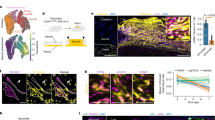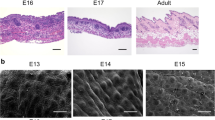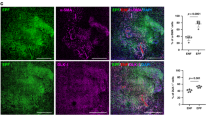Abstract
During fetal development, mammalian back-skin undergoes a natural transition in response to injury, from scarless regeneration to skin scarring. Here, we characterize dermal morphogenesis and follow two distinct embryonic fibroblast lineages, based on their history of expression of the engrailed 1 gene. We use single-cell fate-mapping, live three dimensional confocal imaging and in silico analysis coupled with immunolabelling to reveal unanticipated structural and regional complexity and dynamics within the dermis. We show that dermal development and regeneration are driven by engrailed 1-history-naive fibroblasts, whose numbers subsequently decline. Conversely, engrailed 1-history-positive fibroblasts possess scarring abilities at this early stage and their expansion later on drives scar emergence. The transition can be reversed, locally, by transplanting engrailed 1-naive cells. Thus, fibroblastic lineage replacement couples the decline of regeneration with the emergence of scarring and creates potential clinical avenues to reduce scarring.
This is a preview of subscription content, access via your institution
Access options
Access Nature and 54 other Nature Portfolio journals
Get Nature+, our best-value online-access subscription
$29.99 / 30 days
cancel any time
Subscribe to this journal
Receive 12 print issues and online access
$209.00 per year
only $17.42 per issue
Buy this article
- Purchase on Springer Link
- Instant access to full article PDF
Prices may be subject to local taxes which are calculated during checkout







Similar content being viewed by others
References
Gurtner, G. C., Werner, S., Barrandon, Y. & Longaker, M. T. Wound repair and regeneration. Nature 453, 314–321 (2008).
Ud-Din, S., Volk, S. W. & Bayat, A. Regenerative healing, scar-free healing and scar formation across the species: current concepts and future perspectives. Exp. Dermatol. 23, 615–619 (2014).
Armstrong, J. R. & Ferguson, M. W. Ontogeny of the skin and the transition from scar-free to scarring phenotype during wound healing in the pouch young of a marsupial, Monodelphis domestica. Dev. Biol. 169, 242–260 (1995).
Ihara, S., Motobayashi, Y., Nagao, E. & Kistler, A. Ontogenetic transition of wound healing pattern in rat skin occurring at the fetal stage. Development 110, 671–680 (1990).
Lorenz, H. P., Whitby, D. J., Longaker, M. T. & Adzick, N. S. Fetal wound healing. The ontogeny of scar formation in the non-human primate. Ann. Surg. 217, 391–396 (1993).
Longaker, M. T., Dodson, T. B. & Kaban, L. B. A rabbit model for fetal cleft lip repair. J. Oral Maxillofac. Surg. 48, 714–719 (1990).
Kishi, K., Okabe, K., Shimizu, R. & Kubota, Y. Fetal skin possesses the ability to regenerate completely: complete regeneration of skin. Keio J. Med. 61, 101–108 (2012).
Ferguson, M. W. & O’Kane, S. Scar-free healing: from embryonic mechanisms to adult therapeutic intervention. Philos. T. Roy. Soc. B 359, 839–850 (2004).
Longaker, M. T. et al. Adult skin wounds in the fetal environment heal with scar formation. Ann. Surg. 219, 65–72 (1994).
Cass, D. L. et al. Wound size and gestational age modulate scar formation in fetal wound repair. J. Pediatr. Surg. 32, 411–415 (1997).
Rinkevich, Y. et al. Identification and isolation of a dermal lineage with intrinsic fibrogenic potential. Science 348, aaa2151 (2015).
Muzumdar, M. D., Tasic, B., Miyamichi, K., Li, L. & Luo, L. A global double-fluorescent Cre reporter mouse. Genesis 45, 593–605 (2007).
Joe, A. W. et al. Muscle injury activates resident fibro/adipogenic progenitors that facilitate myogenesis. Nat. Cell Biol. 12, 153–163 (2010).
Uezumi, A., Fukada, S., Yamamoto, N., Takeda, S. & Tsuchida, K. Mesenchymal progenitors distinct from satellite cells contribute to ectopic fat cell formation in skeletal muscle. Nat. Cell Biol. 12, 143–152 (2010).
Cordani, N., Pisa, V., Pozzi, L., Sciorati, C. & Clementi, E. Nitric oxide controls fat deposition in dystrophic skeletal muscle by regulating fibro-adipogenic precursor differentiation. Stem Cells 32, 874–885 (2014).
Crisan, M. et al. A perivascular origin for mesenchymal stem cells in multiple human organs. Cell Stem Cell 3, 301–313 (2008).
Dominici, M. et al. Minimal criteria for defining multipotent mesenchymal stromal cells. The International Society for Cellular Therapy position statement. Cytotherapy 8, 315–317 (2006).
Driskell, R. R. et al. Distinct fibroblast lineages determine dermal architecture in skin development and repair. Nature 504, 277–281 (2013).
Rinkevich, Y., Lindau, P., Ueno, H., Longaker, M. T. & Weissman, I. L. Germ-layer and lineage-restricted stem/progenitors regenerate the mouse digit tip. Nature 476, 409–413 (2011).
Khorasani, H. et al. A quantitative approach to scar analysis. Am. J. Pathol. 178, 621–628 (2011).
Gould, D. J., Vadakkan, T. J., Poché, R. A. & Dickinson, M. E. Multifractal and lacunarity analysis of microvascular morphology and remodeling. Microcirculation 18, 136–151 (2011).
Di leva, A., Esteban, F. J., Grizzi, F., Klonowski, W. & Martín-Landrove, M. Fractals in the neurosciences, part II: clinical applications and future perspectives. Neuroscientist 21, 30–43 (2015).
Rognoni, E. et al. Inhibition of β-catenin signalling in dermal fibroblasts enhances hair follicle regeneration during wound healing. Development 143, 2522–2535 (2016).
Sennett, R. et al. An integrated transcriptome atlas of embryonic hair follicle progenitors, their niche, and the developing skin. Dev. Cell 34, 577–591 (2015).
Seifert, A. W. et al. Skin shedding and tissue regeneration in African spiny mice (Acomys). Nature 489, 561–565 (2012).
Bonenfant, N. R. et al. The effects of storage and sterilization on de-cellularized and re-cellularized whole lung. Biomaterials 34, 3232–3245 (2013).
Parslow, A., Cardona, A. & Bryson-Richardson, R. J. Sample drift correction following 4D confocal time-lapse imaging. J. Vis. Exp. 86, 51086 (2014).
Schneider, C. A., Rasband, W. S. & Eliceiri, K. W. NIH image to ImageJ: 25 years of image analysis. Nat. Methods 9, 671–675 (2012).
Karperien, A. FracLac for ImageJ. 1999–2013; http://rsb.info.nih.gov/ij/plugins/fraclac/FLHelp/Introduction.htm
Acknowledgements
Y.R. was supported by the Human Frontier Science Program Career Development Award (CDA00017/2016), the German Research Foundation (RI 2787/1-1 AOBJ: 628819) and the Fritz–Thyssen–Stiftung (2016-01277). J.L. was supported by the China Scholarship Council. D.C.-G. was supported by the Consejo Nacional de Ciencia y Tecnología (CONACYT) and the Deutscher Akademischer Austauschdienst (DAAD).
Author information
Authors and Affiliations
Contributions
Y.R. outlined and supervised the research narrative and designed all the experiments. D.J. performed the wound-healing studies, the flow cytometric analysis and sorting of EPFs and ENFs, the cell transplantations and decellularized skin transplantations. D.C.-G. and A.S. performed and analysed the clonal analysis studies and generated the confocal images. D.C.-G. performed the fractal analysis. S.C. and P.R. performed live-imaging and cell-tracking analysis. J.L. and V.R. assisted with clonal analysis, confocal imaging and histological sectioning. M.M.D.S. and D.E.W. generated the decellularized dermis. Y.R. wrote the manuscript.
Corresponding author
Ethics declarations
Competing interests
The authors declare no competing interests.
Additional information
Publisher’s note: Springer Nature remains neutral with regard to jurisdictional claims in published maps and institutional affiliations.
Integrated supplementary information
Supplementary Figure 1 Flow cytometric analysis of mesenchymal markers on ENFs and EPFs.
a, single cell suspension was prepared from the pooled back-skin from three E12.5, three E15.5 and one E19.5 En1Cre;R26mTmG embryos, and subjected to flow cytometric analysis. b, Sytox blue was used to exclude dead cells, and APC-conjugated lineage markers (CD45, CD31, Ter119, EpCAM, Tie-2, Lyve-1) were used to exclude non-mesenchymal cells. c–e, representative analysis plots of fibro-adipogenic progenitors (FAPs) (Lin-ITGA7-Sca1+PDGFRa+) (c), pericytes (Lin-CD146+) (d), and mesenchymal stem cells (Lin-CD29+CD105+) (e), and their distributions in ENFs and EPFs. f-g, the percentages of ENFs and EPFs (f) and the ratio of ENFs:EPFs (g) within Lin- cells (initial), FAPs, pericytes and MSCs.
Supplementary Figure 2 Expression of mesoderm markers on ENFs and EPFs by immunofluorescence staining.
Cryosections were prepared from En1Cre;R26VT2/GK3 neonates (P1), and stained with primary antibodies against mouse FABP4 (a), Dlk1 (b), Sca1 (c), aSMA (d), TNC (e), and CD26 (f), and AF647-conjugated respective secondary antibodies. Depicted are representative high-power images of AF647 channel for antibodies (left), GFP-RFP channels for ENFs-EPFs (middle), and merged channels (right). Dotted lines indicate the border of epidermis and dermis, and the border of upper dermis (UD) and lower dermis (LD). Squares indicate the locations of enlarged inserts in merged images. Scales: 50?µm. The depicted are representative images of three individual embryos.
Supplementary Figure 3 EPFs associate with Collagen I fibers.
a–d, Immunofluorescence for Collagen I of E11.5 (a), E12.5 (b), E14.5 (c), or E16.5 (d) En1Cre;R26VT2/GK3 embryos. e-h, EPF- or ENF-signal-derived ROI mean grey value (mgv) ± SEM of the Collagen I signal from anterior or posterior regions of E11.5 (e), E12.5 (f), E14.5 (g), or E16.5 (h) En1Cre;R26VT2/GK3 embryos. n?=?3 optical fields of anterior and posterior regions at each development stage. Two-tailed unpaired t-test. * p<0.05. Scale: 50?µm. Images represent 1 out of three optical fields. The exact p values are listed in Supplementary Table 1.
Supplementary Figure 4 EPFs actively displace provisional ENF dermis.
3D representations of 24 h time-lapse images of EPF-positive anterior region in E12.5 En1Cre;R26mTmG embryo (up). Max projection of whole live embryo showing the area analyzed (down). Scales: 100?µm and 500?µm, respectively. Images are taken from the one representative video used for cell tracking analysis showed in Fig. 3.
Supplementary Figure 5 Fractal analysis of ENFs organizations during development. and subsampled fractal analysis.
a, Graphical representation of the quantitative assessment of complexity and porosity in 2D images by Fractal analysis. b, Representative confocal images of clumped posterior E11.5 EPFs (up), and stretched anterior E12.5 (down) from En1Cre;R26VT2/GK3 embryos. c, Fractal dimension (up) and lacunarity (down) values derived from ENFs of different regions and developmental stages. Mean ± SEM. n?=?9 optical fields of anterior or posterior regions at each developmental stage. RM ANOVA, p?<?0.05, Newman-Keuls test. d, Subsampled (local) fractal analysis (right) of low-power magnification confocal images of E16.5 En1Cre;R26VT2/GK3 embryos (left). Scale: 50?µm. e, Fractal dimension (up) and lacunarity (down) values derived from ENFs of different regions and developmental stages, n?>?60 subsampled values pooled from three confocal images. ANOVA, Tukey test, *p?<?0.05. Box and whiskers plots with minimum, lower quartile, median, upper quartile, and maximum. The exact p values are listed in Supplementary Table 1.
Supplementary Figure 6 Fibronectin matrix stiffens concurrent with EPF expansion.
a–d, Immunofluorescence for Fibronectin in E11.5 (a), E12.5 (b), E14.5 (c), or E16.5 (d) En1Cre;R26VT2/GK3 embryos. e–h, Representative linear profiles of diagonal lines on the Fibronectin signal from E11.5 (e), E12.5 (f), E14.5 (g), or E16.5 (h) images. Dashed lines above the plots represent the calculated distances between fibers. Scale: 50?µm. Images are representatives of 3 optical fields.
Supplementary Figure 7 The fibroblastic lineage replacement drives the transition of dermal response to injury from regeneration to scarring.
ENFs are the primary sculptors that drive dermal lattice development and regeneration during early development, and that their cell lineage declines during development. EPFs that produce mature matrix fibres expand concurrently, and predispose back-skin to scarring.
Supplementary information
Supplementary Information
Supplementary Figures 1–7, Supplementary Table and Videos legends.
Supplementary Table 1
Statistics source data.
Supplementary Video 1
EPFs arch in the developing mouse embryo.
Supplementary Video 2
EPFs actively displace ENFs.
Supplementary Video 3
EPFs actively displace ENFs (only ENFs).
Rights and permissions
About this article
Cite this article
Jiang, D., Correa-Gallegos, D., Christ, S. et al. Two succeeding fibroblastic lineages drive dermal development and the transition from regeneration to scarring. Nat Cell Biol 20, 422–431 (2018). https://doi.org/10.1038/s41556-018-0073-8
Received:
Accepted:
Published:
Issue Date:
DOI: https://doi.org/10.1038/s41556-018-0073-8
This article is cited by
-
Evidence of steady-state fibroblast subtypes in the normal human breast as cells-of-origin for perturbed-state fibroblasts in breast cancer
Breast Cancer Research (2024)
-
Fibroblast and myofibroblast activation in normal tissue repair and fibrosis
Nature Reviews Molecular Cell Biology (2024)
-
Fractal analysis of extracellular matrix for observer-independent quantification of intestinal fibrosis in Crohn’s disease
Scientific Reports (2024)
-
Local and systemic mechanisms that control the hair follicle stem cell niche
Nature Reviews Molecular Cell Biology (2024)
-
Cellular and molecular mechanisms of skin wound healing
Nature Reviews Molecular Cell Biology (2024)



